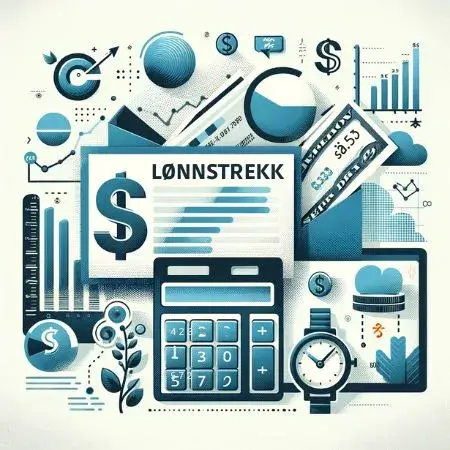In this article, we go through all aspects of wage garnishment. We would like to help you refinance defaulted claims with security in your property, so you can keep your entire salary.
Norsk Refinansiering is a service for those who wish to refinance payment remarks, expensive consumer loans, and creditcards with a mortgage on their property.

When one owes money and this claim is not paid, the creditor (the person you owe money to) has the opportunity to request forced collection of the claim via wage garnishment. The creditor must then follow the debt collection process and must adhere to strict formal requirements. There are several steps in this process, including reminders, collection notices, and payment demands.
A wage garnishment can also arise as a claim for damages. Compensation for damages is one of the most common claims besides loans and bills.
Once these steps are taken, the creditor can finally request forced collection. This could lead to forced sales of property or vehicles, as well as wage garnishments through the employer.
The enforcement officer (Police) then assesses which solution is best. Society does not want forced sales, so the best solution is wage garnishment if deductions from wages and holiday pay are feasible.
Next, the enforcement officer sends out a notice of wage garnishment to map out income and expenses. This is to calculate ensuring that you have enough to cover the rates for necessary living expenses. The surplus liquidity is determined, and this amount is what will be deducted from the salary. The enforcement officer then sends an order to the employer, asking the employer to deduct the amount from the debtor's salary through the employer.
It is crucial to respond to the forms sent by the enforcement officer, as these influence how high your garnishment will be. If you do not respond to the forms, it can result in a garnishment that is much higher than it should be.
One might also risk having multiple wage garnishments before receiving their salary. You can read more about having multiple wage garnishments on our page.

.jpg)
There are 4 agencies that can carry out salary garnishment in Norway. They all follow the same Enforcement Act.
The enforcement officer is responsible for all private law claims, such as loans, collection cases, and bills.
NAV is responsible for incorrectly disbursed NAV benefits and child support.
The Tax Authorities are responsible for tax claims and certain fees associated with companies (value added tax etc.)
SI is responsible for all public claims such as fines, court fees, student loans and the like.
.png)

It is often very confusing to get an overview of one's wage garnishments. Creditors, collection agencies, and public authorities are involved. This makes the process confusing and creates little overview of the wage garnishments.
Therefore, we have written an article, How to get an overview of my wage garnishments, to help you get an overview of your wage garnishments.
Without a doubt, it is the enforcement officer, who is responsible for collections and debt, who is most often represented over claims. Therefore, we have also created a video that explains how you can get an overview of wage garnishments from the enforcement officer.

The enforcement officer has the right to garnish wages to cover a debtor's debt, but there are rules that determine how long and how much can be garnished. The wage garnishment continues until the entire debt is paid, or for a maximum of 24 months.
Wage garnishment for how long? A wage garnishment should therefore last for a maximum of 2 years, but remember that the creditor can request a new garnishment after 2 years. This requires that a new enforcement proceeding be conducted.
It is important to note that there is protection for the debtor so that not the entire salary is taken. A certain portion of the salary should always remain for the debtor to cover basic living expenses. This is determined by subsistence rates. If the debtor's financial situation changes, one can apply for a change in the wage garnishment.

For many, having financial problems is associated with shame. Therefore, many wonder if employers will know that a wage garnishment is being carried out. We have written a separate article about this which explains whether the employer will know about the wage garnishment?
The employer is responsible for deducting the necessary part of the salary and paying it to the right authority when it has been decided that a garnishment should be carried out. This is regulated by the law, and the employer must follow legal procedures.
The boss will find out about the forced garnishment, as it is the employer's responsibility to carry out the deduction from the employee's salary and forward the amount to the creditor.

The most common is that employees only have one garnishment per month, but it happens that one has multiple garnishments. This is often a mistake made when one has garnishments from different agencies, because they do not take each other into account. This is a mistake, and you can read more about whether one can have multiple wage garnishments.
Nevertheless, it's important that an assessment of your financial situation should be made, and it may be wise to seek advice and guidance to find a solution to the financial situation.
There are limitations on how much can be garnished from your income, and you should in any case be left with a certain amount for living expenses.


Having a forced garnishment from one's income is perceived by many as very intrusive. What makes it even harder is that the amounts one is left with after the garnishment are very small. Many cannot live on the rates set by the Parliament, and therefore find the garnishment amount unfair. We will go through some relevant topics.
If a wage garnishment is carried out, it should be taken into account that the employee should retain a certain sum of the salary to cover basic living expenses. This means that net income is calculated, and then reasonable housing expenses as well as living expenses are deducted. We have written an article about how much the enforcement officer is allowed to garnish from wages.
he regulation on subsistence rates, which states that no more should be garnished than what one reasonably needs for maintenance, contains rates for what are called necessary expenses for subsistence as predetermined by the Parliament. This simply means that you should have enough money left to be able to pay necessary expenses such as food, electricity, rent etc. Here you can read about the rates for subsistence.
Our own calculator! You can use our Wage Garnishment calculator to calculate how high your garnishment should be. The calculator takes into account the regulation on subsistence rates, which ensures that you keep enough of the salary to cover basic living expenses.
In case of too high garnishment, you can report changes in your financial situation, so that the one garnishing your wages has the opportunity to change the garnishment amount. This will help you to have some money left over, so that you have the opportunity to pay your other bills. It is important that the salary should be predictable. You may want to read about how you can change your wage garnishment.

To stop a wage garnishment, you need to procure money, or otherwise find a way to pay the money you owe. There are several ways to raise money, and we have written a separate article about specific methods to stop wage garnishments. Here you can read about how it is possible to stop the garnishment, so click on the link and read more. The 5 methods we have described include:
If you have money available, you can pay out the claim that is the basis, and in that way get rid of the garnishment.
Refinancing a loan means that you take out a new loan to pay one or more debt items. If you have available equity in the home, you will get better terms on the money you owe by taking security in the home. By refinancing all the loans you have and including claims that are to wage garnishment, the garnishment will disappear.
If you own a home, you can reduce your costs by buying a cheaper home. This will again give you more money each month that you can use to pay the claim and stop the garnishment. In addition, it can also free up some capital that you can use to pay the outstanding claims.
If you sell some of the things you own, this can help you get extra money that you can use to pay the claim and stop the garnishment. For example, you can look in the storage room, basement, and attic for things you can sell, and you can create an ad for free on Finn.no, and it surely doesn't take more than 2 minutes to post each item.
If you do not own your own home, you can stop the garnishment by refinancing with a guarantor. This means that you take out a loan where another person (or persons) acts as guarantor(s). A guarantor is a person who provides their home as security.
If you do not pay back the loan, these people will be responsible for paying it. It might be an idea to check if friends, family, or close acquaintances have the opportunity to provide their home as security for your loan.
At Norsk Refinansiering, you will receive free help to stop wage garnishment. We are experts on loans with payment remarks. Contact us today.

Namsmannen har rett til å trekke i lønn for å dekke en skyldners gjeld, men det er regler som bestemmer hvor lenge og hvor mye som kan trekkes. Lønnstrekket fortsetter til hele gjelden er betalt, eller maksimalt i 24 måneder.
Et lønnstrekk skal altså maksimalt vare i 2 år, men husk at kreditor kan be om et nytt trekk etter 2 år. Dette krever at det gjennomføres en ny utleggsforretning.
Det er viktig å merke seg at det er en beskyttelse for skyldneren slik at ikke hele lønnen blir tatt. En viss del av lønnen skal alltid være igjen til skyldneren for å dekke grunnleggende levekostnader. Dette er fastsatt i satser for livsopphold. Hvis skyldnerens økonomiske situasjon endrer seg, kan man søke om endring i lønnstrekket.

For mange er det å ha økonomiske problemer forbundet med skam. Derfor lurer mange på om arbeidsgivere for vite om at det blir gjort lønnstrekk. Vi har skrevet en egen artikkel om dette som forklarer får arbeidsgiver vite om lønnstrekk?
Arbeidsgiveren har ansvar for å trekke den nødvendige delen av lønnen og betale den til rett instans når det er vedtatt at trekk skal utføres. Dette er regulert av lovverket, og arbeidsgiveren må følge juridiske prosedyrer.
Sjefen får vite om tvangstrekket, da det er arbeidsgiverens ansvar å gjennomføre trekk av lønnen til den ansatte og sende beløpet videre til kreditoren.
Hva er lønnstrekk?
Kan man ha flere lønnstrekk?
Hvordan fungerer trekk i lønn?
Hvor mye har namsmannen lov å trekke i lønn?
Får arbeidsgiver vite om lønnstrekk?
Hvor lang tid tar det før man får lønnstrekk?
Skal det trekkes lønn av feriepenger?
Livsopphold: Hva er livsopphold satser?